Green Mountains
Sunday, September 17, 2006Tyson, Vermont - 5 miles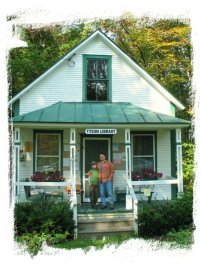
Has a nice sound, doesn’t it? It’s been said that you can always hear the sound of your name spoken in a noisy room. In this case, our last name leapt off the page of the Vermont map as I viewed it plotting our route to Bennington. Only a few miles down the road, and we were going to pass right thru it. Our lucky day!
On the map Tyson appeared to be nothing more than a crossroads. In our experience in Vermont this usually meant only a house or two, so we weren’t expecting much. What a pleasant surprise to find a small village including a church, several inns, a cute little library, a general store, and a lake!
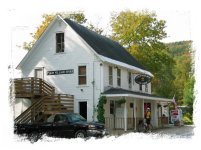
Tyson’s main claim to fame was a foundry, mainly used to cast heating stoves (we found several of these displayed at the Calvin Coolidge Historic Site in nearby Plymouth Notch). At one point the foundry employed upwards of 200 people. Today, Tyson survives mainly on tourists who frequent its two inns and multiple rental cabins. We hoped to have lunch at the Echo Lake Inn, but unfortunately the dining room was booked for a private party, so the Tyson’s
were unable to dine in Tyson ;-(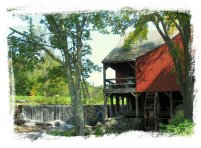
However, the day was young, so we continued down Hwy 100 to our next pit stop, the mill at Weston. The restored grist mill is a familiar sight from numerous coffee table and sightseeing books. We stayed long enough to snap off a few pictures and wander around the small museum inside the mill. The caretaker, upon learning we were from North Carolina, quizzed Vance and I on the usage of a particular saw-like device. After some thinking, I was able to guess correctly that it was used to saw ice. Ice cutting was a big business in Vermont, and the mill ponds provided an ideal spot to harvest the ice.
Our actual destination for the day was the Bennington Museum. During the revolution, the Battle of Bennington occurred nearby (actually across the state line in New York). The museum had a nice exhibit explaining the battle – how it unfolded, and its historical significance in preventing a column of British troops from moving down the lake to link up with the troops at Saratoga Springs – the site of a later, important American victory.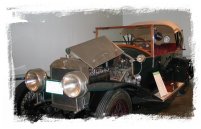
The museum also contained a Martin Wasp – an early car that was manufactured locally. This was another unusual exhibit as the car in question had never been completed - the company went bankrupt for finishing the car (it built mainly custom models), and the car was later 'restored' to show what it would look like completed.
One thing I love about these small town museums is you sometimes walk away with some nugget of historical fact that doesn’t appear in your sanitized 10th grade US history book. In this case, by doing a little reading between the lines, the story of Ethan Allen became a little clearer. First, an interesting side historical oddity: the battle, named after a Vermont town. was actually fought in New York, largely by troops from New Hampshire!
I’d been a bit puzzled why Vermont wasn’t one of the 13 original states (it was the 14th), when Ethan Allen and other Vermonters played such animportant role in the American Revolution. The reason goes something like this….the area of modern day Vermont was claimed by the colonies of both New York and New Hampshire. New Hampshire had gone as far as selling off land grants in the Vermont region, and most people who settled in the area purchased title to their land from the government of New Hampshire, including Ethan and Ira Allen. The territory was largely unsettled until the mid 1760’s and 1770’s, when charters for villages were sold off by New Hampshire.
All and well except that King George III supported New York’s claim to the territory, and being King, his opinion on the matter was what counted. So landholders in Vermont (Ethan Allen being one of the foremost land speculators) faced the potential for their property to be sold to others via the New York claim. This naturally didn’t sit too well with the good folk of Vermont. However, being as it took 3-4 months for a point of argument to make it's way over the ocean and back, the issue remained opened for a period of years.
When the other 13 colonies rebelled, this provided the solution for Vermont landowners – led by Ethan Allen, they joined in the rebellion. However, although Vermont provided troops of militia to aid the Continental Army (the famous Green Mtn Boys), Vermont choose to become independent itself in 1777, adopting its own constitution and government. It was not until 1791, years after the US was formed that Vermont joined as the 14th state.
Militias – military forces that were ‘called up’ on a moments notice, where farmers and townsmen would arm themselves with their own personal weapons, were notoriously unreliable when facing professional British troops. Bennington was one of the early (and few) examples where militia fought the British head on and won. Militia did have advantages, as noted by British General John Burgoyne:
Wherever the King’s forces point, Militia, to the amount of three or four thousand, assemble in 24 hours; they bring with them their own sustenance, &c. and, the alarm over, they return to their farms. The Hampshire Grants [Vermont], in particular, a country unpeopled, and almost unknown the last war, now abounds in the most active and rebellious race on the continent, and hangs like a gathering storm on my left.
The British goal at the Battle of Bennington was to capture an American supply post, as they were running low. The supply line back to Canada was getting lengthy and unprotected. The lack of supplies later led to Burgoyne surrendering his entire force at Saratoga. Bennington played a large role in forcing this.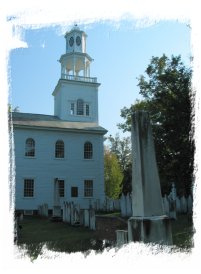
Just up the hill from the Museum was ‘The Old First Church’, which literally was the first church in Vermont. It’s a beautiful building, and is exactly what you would expect from an old New England church. The graveyard is famous for being the final resting place of 5 Vermont governors, 46 veterans of the Revolutionary War (their gravesites are marked by small American Flags), and a mass grave containing the remains of British soldiers and German Hessians who died of injuries as prisoners after the Battle of Bennington.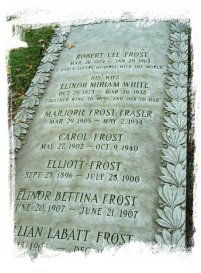
Finally, the most famous gravesite is that of the poet Robert Frost. Although not known to be particularly religious, Frost apparently loved the graveyard, and bought a couple of plots during an expansion of the cemetery. He is buried facing away from the church, but looking down the hill over the town of Bennington, toward the Green Mtns.
'I had a lovers quarrel with the world' - Epitaph: Robert Frost
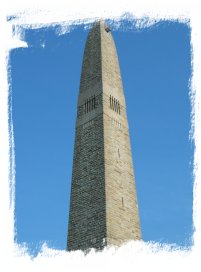
After the church visit we looked at a few covered bridges in the area, then went to the Bennington Monument. This is a monument to the Battle of Bennington, and looks like a smaller version of the Washington Monument. At just over 300 feet, it’s the tallest structure in Vermont. There is a smaller statue of John Stark at the base, Stark being the commander of the American troops at Bennington.
Although a long day, Vance hung in pretty good. He was particularly interested in the Martin Wasp – the museum had an activity sheet where you could draw your own design for the car, and he drew up three of them. He also got a kick out of touching a British cannonball.

Vance: Bennington was a place of fame. On our way there we stopped at a little town called Tyson and got a few pictures. We also made a few stops to see some covered bridges. When we reached Bennington we went to the museum. One exhibit was about an old car called the Martin Wasp, which was built in Bennington. There also was the Bennington Flag that was used during the Battle of Bennington in the American Revolution.
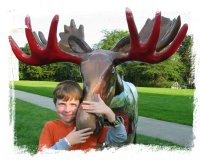
In the museum they had one exhibit where you could touch a British cannonball. Next we saw an old fashion schoolhouse. Then we saw the graveyard where the poet, Robert Frost rests in peace with his family. Many German Hessians and British soldiers killed in the Battle of Bennington are buried there.
Finally we went up in the Battle Monument, and took a couple of pictures of the “covered bridge moose”.
P.S. Bennington was a Battlefield where we fought for our freedom and the right to have our own country!
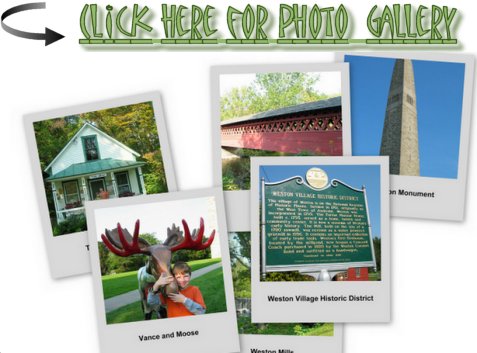







<< Home